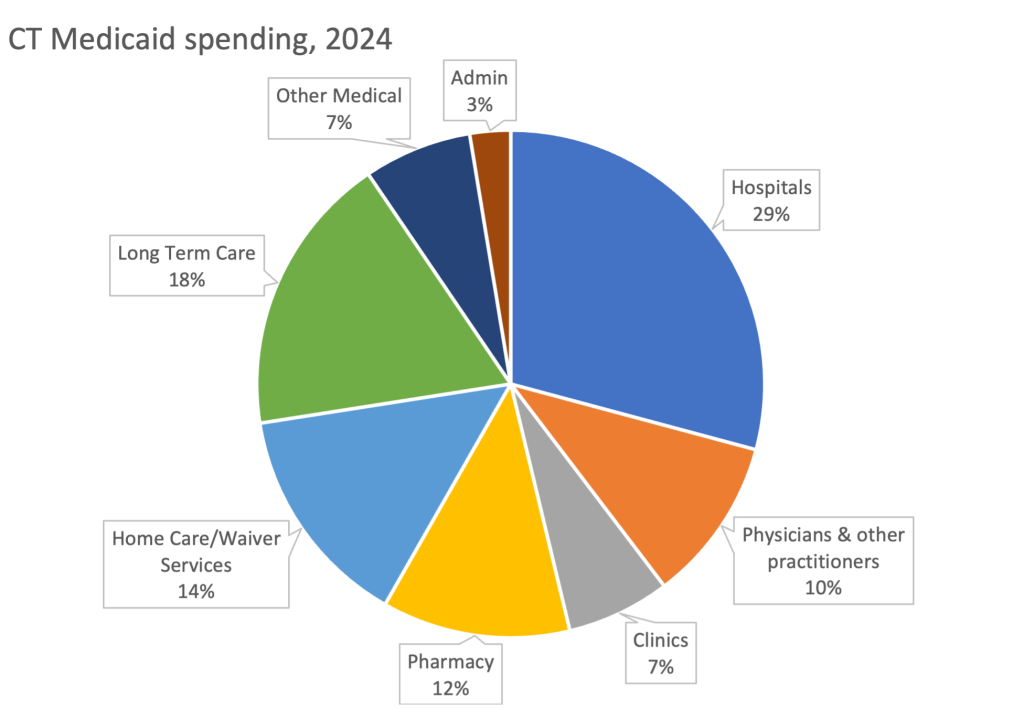insurance
CT healthcare costs grew faster than ever in 2023, but Medicaid bucked the trend
Download the analysis updated 7/22/2025 This month, the Office of Health Strategy (OHS) released their three annual Healthcare Benchmark reports. The main event, the Cost Growth Benchmark report finds that healthcare costs rose by 7.8% in 2023, well above the 2.9% benchmark set by an old OHS committee based on economic indicators. This is the…
Read MoreNutrition initiative could save $908 million per year in CT healthcare spending – Potential Medicaid LTC spending relief option
Medically tailored meals (MTMs) could save Connecticut $6,299 net per year per person, by far the highest savings among states, according to a new study published in Health Affairs. This research offers an important option to address Connecticut Medicaid long-term care costs that not only saves money, but also improves health. MTMs are nutritious, prepared…
Read MoreReform section updated in CT Healthcare Explained
We’ve updated the Reform chapter of CT Healthcare Explained, our explainer website cutting through the complexities of our state’s healthcare system. Like the other 17 topic sections, Reform includes a Basics summary and a much longer Deeper Dive into the issue. In the left hand box, you can skip to your specific question. There is…
Read MoreHUSKY still very efficient but drugs are driving up costs
Read the full report Like other states, Connecticut Medicaid per member costs are beginning to increase after dropping during COVID. However, Connecticut’s rate trend remains better than other states. Since switching from managed care organizations in 2012 to focus on care management, Connecticut Medicaid spending stabilized while enrollment expanded significantly, according to the state’s latest…
Read MoreCT is the 6th most expensive state for smokers costing more than $5 million over a lifetime
Smoking is terrible for your health — tobacco kills 4,900 Connecticut residents each year. However, it’s also a very expensive bad habit. A new analysis by WalletHub estimates lifetime costs for Connecticut smokers at $5,035,722 or $104,911 annually. This is the sixth highest smoking burden among states. The researchers modeled the costs for a pack-a-day…
Read MoreAnalysis: Hartford HealthCare Settlement with St. Francis Still Leaves Two Important Class Action Suits Active
CT News Junkie reports that St. Francis Hospital and Medical Center has reached a settlement with Hartford HealthCare in their lawsuit alleging unfair business practices. It’s good that St. Francis’s complaints as a competitor have been addressed, but the concerns of consumers and payers are still outstanding in two class action lawsuits against Hartford HealthCare.…
Read MoreAnalysis: Despite the name, value is not the solution for raging healthcare costs
The murder of a United health executive has intensified very strong reactions to America’s broken healthcare system. Unfortunately, too many opportunists are using this tragedy to push a tired, failed agenda – value-based care and its corollary, Accountable Care Organizations (ACOs). Read more
Read MoreWandering around in OHS’s databases – lots to learn and a surprise
Our state Office of Health Strategy has several impressive portals and dashboards to explore their trove of data and other information. They include healthcare affordability, ED visits, quality ratings, facility plans, self-sufficiency tools, hospital finances, prescription drug costs, and Race, ethnicity and language data. Visitors can sort the data by service, payer, age, gender, and…
Read MoreICER’s 4th annual report finds progress in fair access to prescription drugs
Over the last four years, barriers facing patients getting access to cost effective drugs in commercial plans and the Veteran’s Administration have gotten better, according to ICER’s fourth annual Barriers to Fair Access report. The authors compare plan policies, including cost sharing, clinical eligibility, step therapy and provider restrictions, to independent standards for fair access…
Read MoreMaterials from webinar on improved HUSKY cancer survival in CT without MCOs
Yesterday, Dr. John Cramer described his study published earlier this year describing a significant increase in cancer survival and early detection in Connecticut’s Medicaid program when the Managed Care Organizations left in 2012. Click here for slides and here for a recording of the webinar. The study — Association of Medicaid Privatization With Patient Cancer…
Read More








